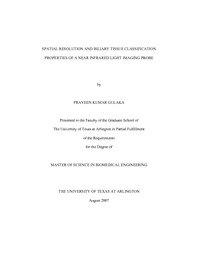
ATTENTION: The works hosted here are being migrated to a new repository that will consolidate resources, improve discoverability, and better show UTA's research impact on the global community. We will update authors as the migration progresses. Please see MavMatrix for more information.
Show simple item record
| dc.contributor.author | Gulaka, Praveen Kumar | en_US |
| dc.date.accessioned | 2007-10-08T23:55:06Z | |
| dc.date.available | 2007-10-08T23:55:06Z | |
| dc.date.issued | 2007-10-08T23:55:06Z | |
| dc.date.submitted | August 2007 | en_US |
| dc.identifier.other | DISS-1825 | en_US |
| dc.identifier.uri | http://hdl.handle.net/10106/649 | |
| dc.description.abstract | Approximately 500,000 Gallbladder Surgeries or Laparoscopic Cholecystectomies are performed annually to remove the Gallbladder. This surgery becomes necessary due to formation of gall stones. As biliary tract tissues are embedded in fat, differentiating them from neighboring tissues and blood vessels is critical in helping surgeons during laparoscopic cholecystectomy to avoid post-surgical complications. Optical spectroscopy (in both visible and near infrared regions) is investigated as a possible technique to identify biliary tract tissues and blood vessels. Such reflectance measurements provide information of effective attenuation, which is an index of optical properties of the tissue.Specifically, optical reflectance measurements were made on biliary tract tissues of 8 alive pigs with a source-detector separation of 9.5 mm, which allows us to probe a tissue depth of 4 mm beneath the tissue surface. Measured reflectance spectra were then fit with a summation of three radial basis functions (rbf). Each radial basis function was expressed by three parameters pertaining to intensity, width and the central wavelength. Therefore, nine parameters were obtained from the fit for each spectrum. In order to develop a simple classification algorithm, three effective parameters were further derived from the nine available parameters. A minimum distance based classification algorithm was developed to classify different types of tissues using their respective parameters.Furthermore, reconstructed images of blood vessels and biliary tree underlying fat have a limited spatial resolution if the probe has a large source-detector separation. To understand this problem, computational and laboratory phantom studies were performed to reveal optimal source-detector separations for the proposed application and for an improved spatial resolution of the probe. To counter the inherent blurring associated with optical images, a modified second derivative algorithm was implemented. | en_US |
| dc.description.sponsorship | Liu, Hanli | en_US |
| dc.language.iso | EN | en_US |
| dc.publisher | Biomedical Engineering | en_US |
| dc.title | Spatial Resolution And Biliary Tissue Classification Properties Of A Near Infrared Light Imaging Probe | en_US |
| dc.type | M.S. | en_US |
| dc.contributor.committeeChair | Liu, Hanli | en_US |
| dc.degree.department | Biomedical Engineering | en_US |
| dc.degree.discipline | Biomedical Engineering | en_US |
| dc.degree.grantor | University of Texas at Arlington | en_US |
| dc.degree.level | masters | en_US |
| dc.degree.name | M.S. | en_US |
| dc.identifier.externalLink | https://www.uta.edu/ra/real/editprofile.php?onlyview=1&pid=28 | |
| dc.identifier.externalLinkDescription | Link to Research Profiles | |
Files in this item
- Name:
- umi-uta-1825.pdf
- Size:
- 1.158Mb
- Format:
- PDF
This item appears in the following Collection(s)
Show simple item record


